Anti-Senescence and Anti-Photoaging Activities of Mangosteen Pericarp Extract on UVA-Induced Fibroblasts
Abstract
1. Introduction
2. Materials and Methods
2.1. Extraction of Mangosteen Pericarp
2.2. Quantification of α-Mangostin in MPE
2.3. UV Determination of MPE and α-Mangostin
2.4. Evaluation of Cytotoxicity of PHDFs Treated with MPE
2.5. Evaluation of UVA-Induced Fibroblast Senescence Using the Senescence-Associated β-Galactosidase (SA-β-Gal) Assay
2.6. Evaluation of Antioxidant Effect of MPE on H2O2-Induced Intracellular ROS Generation
2.7. Evaluation of Photoprotective Effects of MPE on UVA-Induced Fibroblasts Aging
2.7.1. SA-β-Gal Assay
2.7.2. MMP-1 ELISA Assay
2.7.3. Pro-Collagen Type I ELISA Assay
3. Results
3.1. Characteristics of MPE and Quantification of α-Mangostin
3.2. UV-Vis Absorption Profile of MPE and α-Mangostin
3.3. Viability of PHDFs Treated with MPE
3.4. The Effect of UVA-Induced Fibroblast Senescence
3.5. Antioxidant Effect of MPE on H2O2-Induced Intracellular ROS Generation
3.6. Photoprotective Effects of MPE on UVA-Induced Fibroblasts Aging
3.6.1. SA-β-Gal Expression
3.6.2. MMP-1 Expression
3.6.3. Pro-Collagen Type I Expression
4. Discussion
5. Conclusions
Author Contributions
Funding
Institutional Review Board Statement
Informed Consent Statement
Data Availability Statement
Acknowledgments
Conflicts of Interest
References
- Matsumura, Y.; Ananthaswamy, H.N. Toxic effects of ultraviolet radiation on the skin. Toxicol. Appl. Pharmacol. 2004, 195, 298–308. [Google Scholar] [CrossRef] [PubMed]
- D’Orazio, J.; Jarrett, S.; Amaro-Ortiz, A.; Scott, T. UV Radiation and the Skin. Int. J. Mol. Sci. 2013, 14, 12222–12248. [Google Scholar] [CrossRef] [PubMed]
- Fisher, G.J.; Wang, Z.Q.; Datta, S.C.; Varani, J.; Kang, S.; Voorhees, J.J. Pathophysiology of premature skin aging induced by ultraviolet light. N. Engl. J. Med. 1997, 337, 1419–1428. [Google Scholar] [CrossRef]
- Ma, W.M.; Wlaschek, I.; Tantcheva-Poor, L.A.; Schneider, L.; Naderi, Z.; Razi-Wolf, J.S.; Scharffetter-Kochanek, K. Chronological ageing and photoageing of the fibroblasts and the dermal connective tissue. Clin. Exp. Dermatol. 2001, 26, 592–599. [Google Scholar] [CrossRef]
- Wlaschek, M.I.; Tantcheva-Poor, L.; Naderi, W.; Ma, L.A.; Schneider, Z.; Razi-Wolf, J.S.; Scharffetter-Kochanek, K. Solar UV irradiation and dermal photoaging. J. Photochem. Photobiol B Biol. 2001, 63, 41–51. [Google Scholar] [CrossRef]
- Landau, M. Exogenous factors in skin aging. In Current Problems in Dermatology; Karger: Basel, Switzerland, 2007; Volume 35, pp. 1–13. [Google Scholar]
- Liu, S.; Mohri, S.; Manabe, Y.; Ejima, A.; Sato, K.; Sugawara, T. Gly-Pro protects normal human dermal fibroblasts from UVA-induced damages via MAPK-NF-κB signaling pathway. J. Photochem. Photobiol. B Biol. 2022, 237, 112601. [Google Scholar] [CrossRef]
- Nakyai, W.; Saraphanchotiwitthaya, A.; Viennet, C.; Humbert, P.; Viyoch, J. An in vitro Model for Fibroblast Photoaging Comparing Single and Repeated UVA Irradiations. Photochem. Photobiol. 2017, 93, 1462–1471. [Google Scholar] [CrossRef]
- Jung, H.O.; Fatih, K.; Chang-Suk, K.; Youngwan, S. Antiphotoaging Effect of 3,5-Dicaeoyl-epi-quinic Acid against UVA-Induced Skin Damage by Protecting Human Dermal Fibroblasts In Vitro. Int. J. Mol. Sci. 2020, 21, 7756. [Google Scholar]
- Luangpraditkun, K.; Pimjuk, P.; Phimnuan, P.; Wisanwattana, W.; Wisespongpand, C.; Waranuch, N.; Viyoch, J. Anti-Aging Properties of Cannabis sativa Leaf Extract against UVA Irradiation. Cosmetics 2024, 11, 45. [Google Scholar] [CrossRef]
- Yi, Y.; Xie, H.; Xiao, X.; Wang, B.; Du, R.; Liu, Y.; Li, Z.; Wang, J.; Sun, L.; Deng, Z.; et al. Ultraviolet A irradiation induces senescence in human dermal fibroblasts by down-regulating DNMT1 via ZEB1. Aging 2018, 10, 212–228. [Google Scholar] [CrossRef]
- Gen-Long, B.; Ping, W.; Xin, H.; Zi-Yue, W.; Di, C.; Chuan, L.; Yi-Yi, L.; Ruo-Lin, L.; Ai-Jun, C. Rapamycin Protects Skin Fibroblasts From UVA-Induced Photoaging by Inhibition of p53 and Phosphorylated HSP27. Front. Cell Dev. Biol. 2021, 9, 633331. [Google Scholar]
- Yao, X.; Li, H.; Chen, L.; Tan, L.P. UV-induced senescence of human dermal fibroblasts restrained by low-stiffness matrix by inhibiting NF-κB activation. Eng. Regen. 2022, 3, 365–373. [Google Scholar] [CrossRef]
- Lämmermann, I.; Terlecki-Zaniewicz, L.; Weinmüllner, R.; Schosserer, M.; Dellago, H.; de Matos Branco, A.D.; Autheried, D.; Sevcnikar, B.; Kleissl, L.; Berlin, I.; et al. Blocking negative effects of senescence in human skin fibroblasts with a plant extract. npj. Aging Mech. Dis. 2018, 4, 4. [Google Scholar] [CrossRef]
- Weecharangsan, W.; Opanosopit, P.; Sukma, M.; Ngawhirunpat, T.; Sotanaphun, U.; Siripong, P. Antioxidative and neuroprotective activities of extracts from the fruit hull of mangosteen (Garcinia mangostana Linn.). Med Princ. Pract. 2006, 15, 281–287. [Google Scholar] [CrossRef]
- Xie, Z.; Sintara, M.; Chang, T.; Ou, B. Daily consumption of a mangosteen-based drink improves in vivo antioxidant and anti-inflammatory biomarkers in healthy adults: A randomized, double-blind, placebo-controlled clinical trial. Food Sci. Nutr. 2015, 3, 342–348. [Google Scholar] [CrossRef] [PubMed]
- Beatrice, E.; Pietradewi, H. Evaluation of mangosteen (Garcinia mangostana) antioxidant activity in clinical trials and in vivo animal studies: A systematic review. J. Appl. Pharm. Sci. 2020, 10, 114–129. [Google Scholar] [CrossRef]
- Tangyuenyongwatana, P.; Gritsanapan, W. Development of sunscreen containing alpha-mangostin riched extract with anti-tyrosinase activities. Chiang Mai Univ. J. Nat. Sci. 2022, 21, e2022064. [Google Scholar] [CrossRef]
- Chen, L.G.; Yang, L.L.; Wang, C.C. Anti-inflammatory activity of mangostins from Garcinia mangostana. Food Chem. Toxicol. 2008, 46, 688–693. [Google Scholar] [CrossRef]
- Tewtrakul, S.; Wattanapiromsakul, C.; Mahabusarakam, W. Effects of compounds from Garcinia mangostana on inflammatory mediators in RAW264.7 macrophage cells. J. Ethnopharmacol. 2009, 121, 379–382. [Google Scholar] [CrossRef]
- Herrera-Aco, D.R.; Medina-Campos, O.N.; Pedraza-Chaverri, J.; Sciutto-Conde, E.; Rosas-Salgado, G.; Fragoso-González, G. Alpha-mangostin: Anti-inflammatory and antioxidant effects on established collagen-induced arthritis in DBA/1J mice. Food Chem. Toxicol. 2019, 124, 300–315. [Google Scholar] [CrossRef]
- Chomnawang, T.M.; Surassmo, S.; Nukoolkarn, V.S.; Gritsanapan, W. Antimicrobial effects of Thai medicinal plants against acne-inducing bacteria. J. Ethnopharmacol. 2005, 101, 330–333. [Google Scholar] [CrossRef] [PubMed]
- Carvalho-Silva, R.; Pereira, A.C.; Dos Santos Alves, R.P.; Guecheva, T.N.; Henriques, J.A.; Brendel, M.; Pungartnik, C.; Rios-Santos, F. DNA Protection against Oxidative Damage Using the Hydroalcoholic Extract of Garcinia mangostana and Alpha-Mangostin. Evid.-Based Complement. Altern. Med. 2016, 2016, 3430405. [Google Scholar] [CrossRef]
- Singh Gill, T.J.; Dewi Ratnayanti, I.G.A.; Nyoman Arijana, I.G.K. The effect of purple mangosteen (Garcinia mangostana) peel extract on collagen fiber in male Wistar rats after Ultraviolet-B (UV-B) exposure. Intisari Sains Medis 2018, 9, 131–134. [Google Scholar]
- Abdi, D.A.; Massi, N.; Djawad, K.; Vitayani, S.; Nurmadilla, N. Effect of Photoprotective Cream of Mangosteen Pericarp Extract (Garcinia Mongostana L) Against 8-OHdG After UVB Exposure On Albino Mice. Indian J. Forensic Med. Toxicol. 2021, 15, 2240–2244. [Google Scholar] [CrossRef]
- Im, A.; Kim, Y.; Chin, Y.; Chae, S. Protective effects of compounds from Garcinia mangostana L. (mangosteen) against UVB damage in HaCaT cells and hairless mice. Int. J. Mol. Med. 2017, 40, 1941–1949. [Google Scholar] [CrossRef][Green Version]
- Pothitirat, W.; Chomnawang, M.T.; Supabphol, R.; Gritsanapan, W. Free radical scavenging and anti-acne activities of mangosteen fruit rind extracts prepared by different extraction methods. Pharm. Biol. 2010, 48, 182–186. [Google Scholar] [CrossRef]
- Kongkiatpaiboon, S.; Vongsak, B.; Machana, S.; Weerakul, T.; Pattarapanich, C. Simultaneous HPLC quantitative analysis of mangostin derivatives in Tetragonula pagdeni propolis extracts. J. King Saud Univ.-Sci. 2016, 28, 131–135. [Google Scholar] [CrossRef]
- Madihah, A.; Bohari, Y.; Azwan, M.L. A study on dispersion and characterisation of α-mangostin loaded pH sensitive microgel systems. Chem. Cent. J. 2013, 7, 85. [Google Scholar]
- Sang-aroon, W.; Tontapha, S.; Promgool, T.; Amornkitbamrung, V.; Kanokmdehakul, S. Effects of dye-adsorption solvents, acidification and dye combination on efficiency of DSSCs sensitized by α-mangostin and anthocyanin from mangosteen pericarp. J. Mater. Sci. Mater. Electron. 2017, 337, 1419–1428. [Google Scholar]
- Wang, X.; Hong, H.; Wu, J. Hen collagen hydrolysate alleviates UVA-induced damage in human dermal fibroblasts. J. Funct. Foods 2019, 63, 103574. [Google Scholar] [CrossRef]
- Betul, K.; Isabella, Z.; Nicolle, B.; Tobias, J.; Annika, H.; Buket, A.; Schroeder, P.; Chondrogianni, N.; Gonos, E.S.; Isabelle, P.; et al. The Proteasome Is an Integral Part of Solar Ultraviolet A Radiation-induced Gene Expression. J. Biol. Chem. 2009, 284, 30076–30086. [Google Scholar]
- Tiraravesit, N.; Yakaew, S.; Rukchay, R.; Luangbudnark, W.; Viennet, C.; Humbert, P.; Viyoch, J. Artocarpus altilis heartwood extract protects skin against UVB in vitro and in vivo. J. Ethnopharmacol. 2015, 4, 153–162. [Google Scholar] [CrossRef] [PubMed]
- Nichols, J.; Katiyar, S. Skin photoprotection by natural polyphenols: Anti-inflammatory, antioxidant and DNA repair mechanisms. Arch. Dermatol. Res. 2010, 302, 71–83. [Google Scholar] [CrossRef]
- Tu, Y.; Quan, T. Oxidative Stress and Human Skin Connective Tissue Aging. Cosmetics 2016, 3, 28. [Google Scholar] [CrossRef]
- Ihsanpuro, S.I.; Gunawan, S.; Ibrahim, R.; Aparamarta, H.W. Extract with high 1,1-diphenyl-2-picrylhydrazyl (DPPH) inhibitory capability from pericarp and seed of mangosteen (Garcinia mangostana L.) using microwave-assisted extraction (MAE) two-phase solvent technique. Arab. J. Chem. 2022, 15, 104310. [Google Scholar] [CrossRef]
- Tjahjani, S.; Widowati, W.; Khiong, K.; Suhendra, A.; Tjokropranoto, R. Antioxidant Properties of Garcinia mangostana L (Mangosteen) Rind. Procedia Chem. 2014, 13, 198–203. [Google Scholar] [CrossRef]
- Qin, Z.; Robichaud, P.; He, T.; Fisher, G.J.; Voorhees, J.J.; Quan, T. Oxidant exposure induces cysteine-rich protein 61 (CCN1) via c-Jun/AP-1 to reduce collagen expression in human dermal fibroblasts. PLoS ONE 2014, 9, e115402. [Google Scholar] [CrossRef] [PubMed]
- Fisher, G.J.; Quan, T.; Purohit, T.; Shao, Y.; Cho, M.K.; He, T.; Varani, J.; Kang, S.; Voorhees, J.J. Collagen fragmentation promotes oxidative stress and elevates matrix metalloproteinase-1 in fibroblasts in aged human skin. Am. J. Pathol. 2009, 174, 101–114. [Google Scholar] [CrossRef]
- Quan, T.; Little, E.; Quan, H.; Qin, Z.; Voorhees, J.J.; Fisher, G.J. Elevated matrix metalloproteinases and collagen fragmentation in photodamaged human skin: Impact of altered extracellular matrix microenvironment on dermal fibroblast function. J. Investig. Dermatol. 2013, 133, 1362–1366. [Google Scholar] [CrossRef]
- McHugh, D.; Gil, J. Senescence and aging: Causes, consequences, and therapeutic avenues. J. Cell Biol. 2018, 217, 65–77. [Google Scholar] [CrossRef]
- Mavrogonatou, E.; Konstantinou, A.; Kletsas, D. Long-term exposure to TNF-α leads human skin fibroblasts to a p38 MAPK- and ROS-mediated premature senescence. Biogerontology 2018, 19, 237–249. [Google Scholar] [CrossRef]
- Zhang, J.; Yu, H.; Man, M.Q.; Hu, L. Aging in the dermis: Fibroblast senescence and its significance. Aging Cell 2024, 23, e14054. [Google Scholar] [CrossRef]
- Ding, Y.; Jiratchayamaethasakul, C.; Lee, S.-H. Protocatechuic Aldehyde Attenuates UVA-induced Photoaging in Human Dermal Fibroblast Cells by Suppressing MAPKs/AP-1 and NF-κB Signaling Pathways. Int. J. Mol. Sci. 2020, 21, 4619. [Google Scholar] [CrossRef]
- Wang, X.; Bi, Z.; Chu, W.; Wan, Y. IL-1 receptor antagonist attenuates MAP kinase/AP-1 activation and MMP1 expression in UVA-irradiated human fibroblasts induced by culture medium from UVB-irradiated human skin keratinocytes. Int. J. Mol. Med. 2005, 16, 6, 1117–1124. [Google Scholar] [CrossRef]
- Magenta, A.; Cencioni, C.; Fasanaro, P.; Zaccagnini, G.; Greco, S.; Sarra-Ferraris, G.; Antonini, A.; Martelli, F.; Capogrossi, M.C. miR-200c is upregulated by oxidative stress and induces endothelial cell apoptosis and senescence via ZEB1 inhibition. Cell Death Differ. 2011, 18, 1628–1639. [Google Scholar] [CrossRef]
- Yoshikawa, M.; Harada, E.; Miki, A.; Tsukamoto, K.; Liang, S.Q.; Yamahara, J.; Murakami, N. Antioxidant constituents from the fruit hulls of mangosteen (Garcinia mangostana L.) originating in Vietnam. Yakugaku Zasshi 1994, 114, 129–133. [Google Scholar] [CrossRef]
- Wittenauer, J.; Falk, S.; Schweiggert-Weisz, U.; Carle, R. Characterisation and quantification of xanthones from the aril and pericarp of mangosteens (Garcinia mangostana L.) and a mangosteen containing functional beverage by HPLC–DAD–MSn. Food Chem. 2012, 134, 445–452. [Google Scholar] [CrossRef]
- Aisha, A.F.; Abu-Salah, K.M.; Siddiqui, M.J.; Ismail, Z.; Majid, A.M.S.A. Quantification of α-, β-and γ-mangostin in Garcinia mangostana fruit rind extracts by a reverse phase high performance liquid chromatography. J. Med. Plant Res. 2012, 6, 4526–4534. [Google Scholar]
- Chomnawang, M.T.; Surassmo, S.; Nukoolkarn, V.S.; Gritsanapan, W. Effect of Garcinia mangostana on inflammation caused by Propionibacterium acnes. Fitoterapia 2007, 78, 401–408. [Google Scholar] [CrossRef]
- Mohan, S.; Syam, S.; Abdelwahab, S.I.; Thangavel, N. An anti-inflammatory molecular mechanism of action of α-mangostin, the major xanthone from the pericarp of Garcinia mangostana: An in silico, in vitro and in vivo approach. Food Funct. 2018, 9, 3860–3871. [Google Scholar] [CrossRef]
- Jin, J.; Bao, Y.; Wang, Y.; Zheng, H.; Guo, H.; Zhang, L.; Guo, R.; Yang, L. Protective Activity of Alpha-Mangostin against UVB-Induced Injury in HaCaT Cells by Modulating the Ceramide and MAPK and NF-κB Signaling Pathways. J. Food Biochem. 2023, 2023, 1–11. [Google Scholar] [CrossRef]
- Franceschelli, S.; Pesce, M.; Ferrone, A.; Patruno, A.; Pasqualone, L.; Carlucci, G.; Ferrone, V.; Carlucci, M.; de Lutiis, M.A.; Grilli, A.; et al. A Novel Biological Role of α-Mangostin in Modulating Inflammatory Response Through the Activation of SIRT-1 Signaling Pathway. J. Cell. Physiol. 2016, 231, 2439–2451. [Google Scholar] [CrossRef] [PubMed]
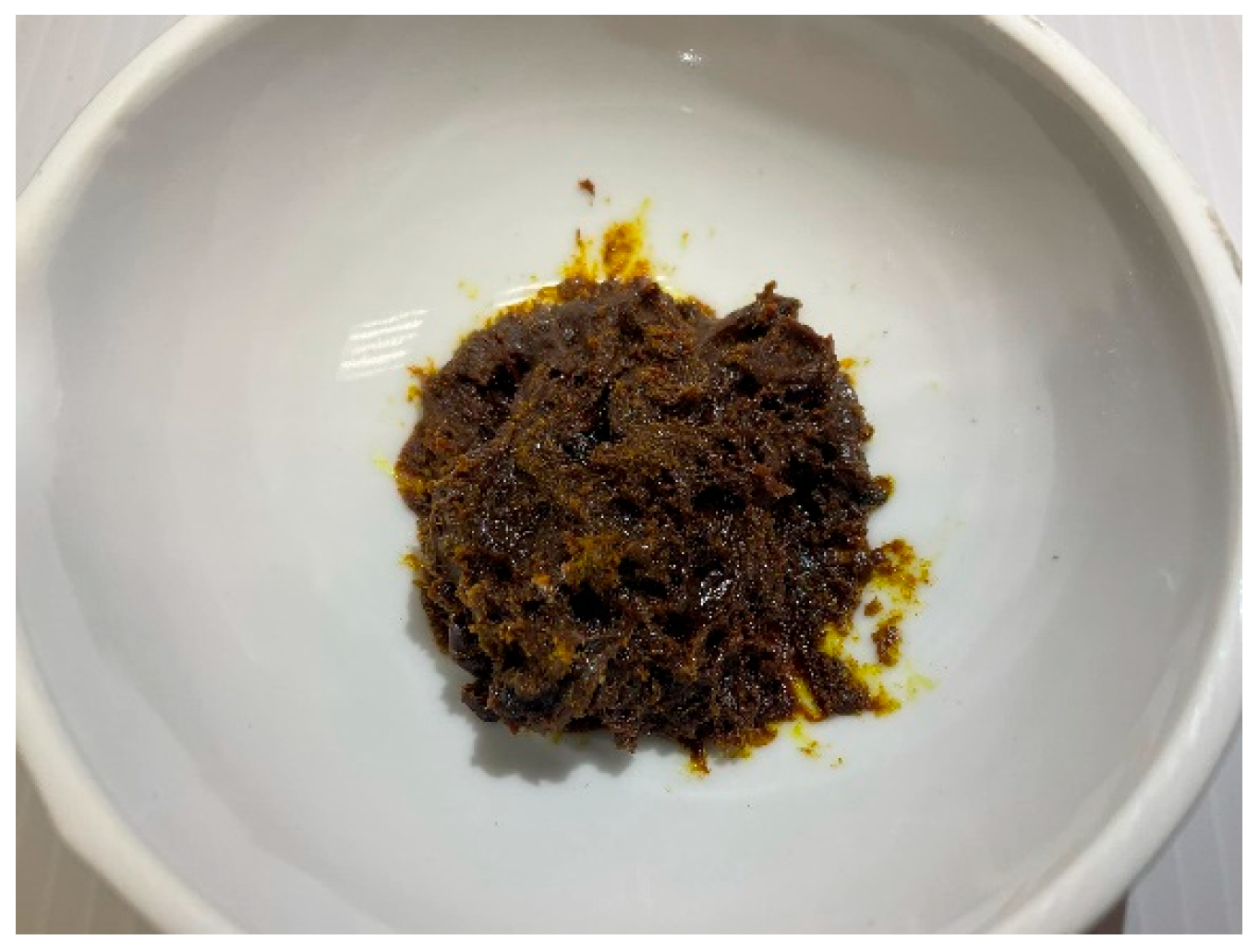
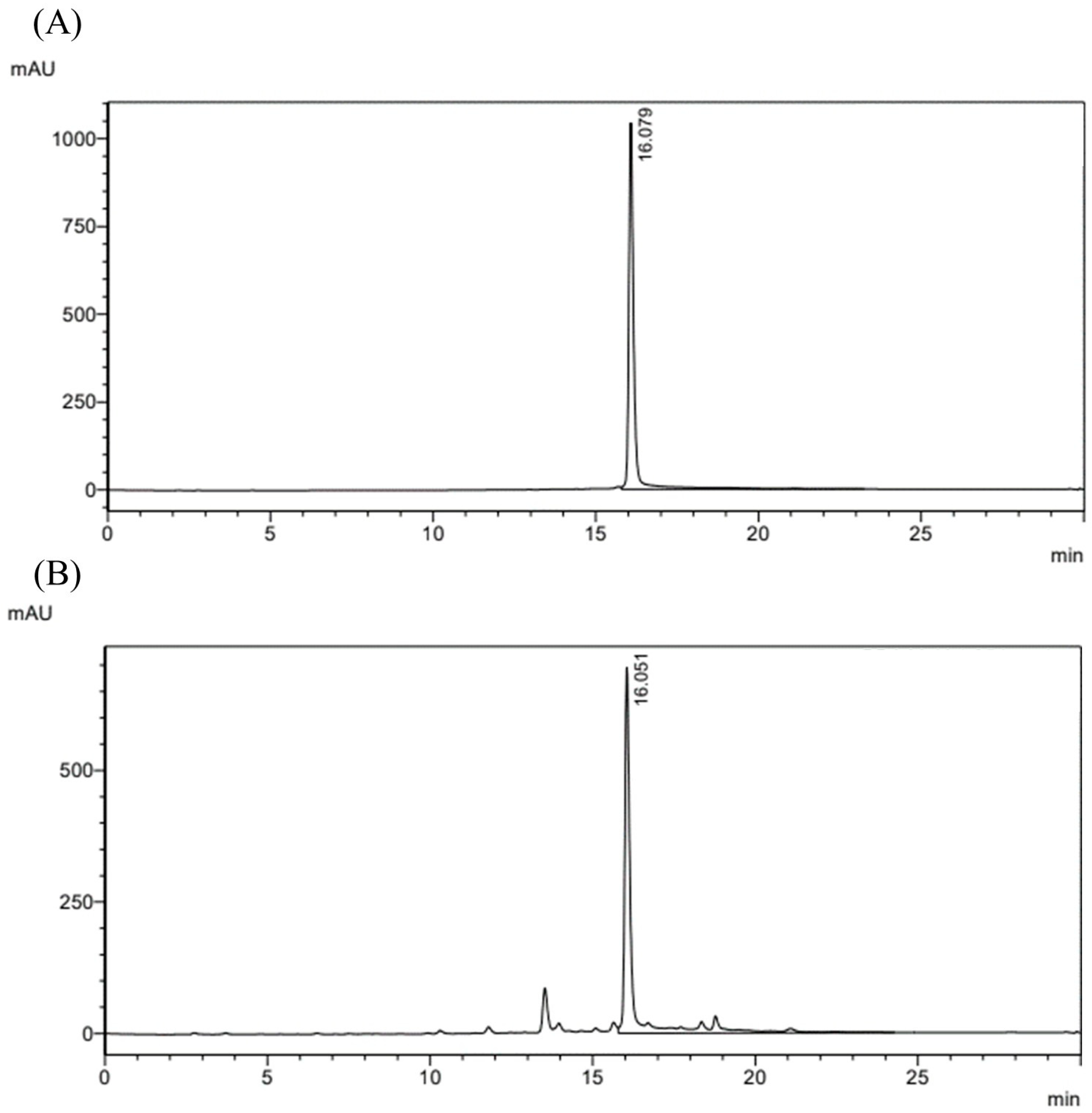

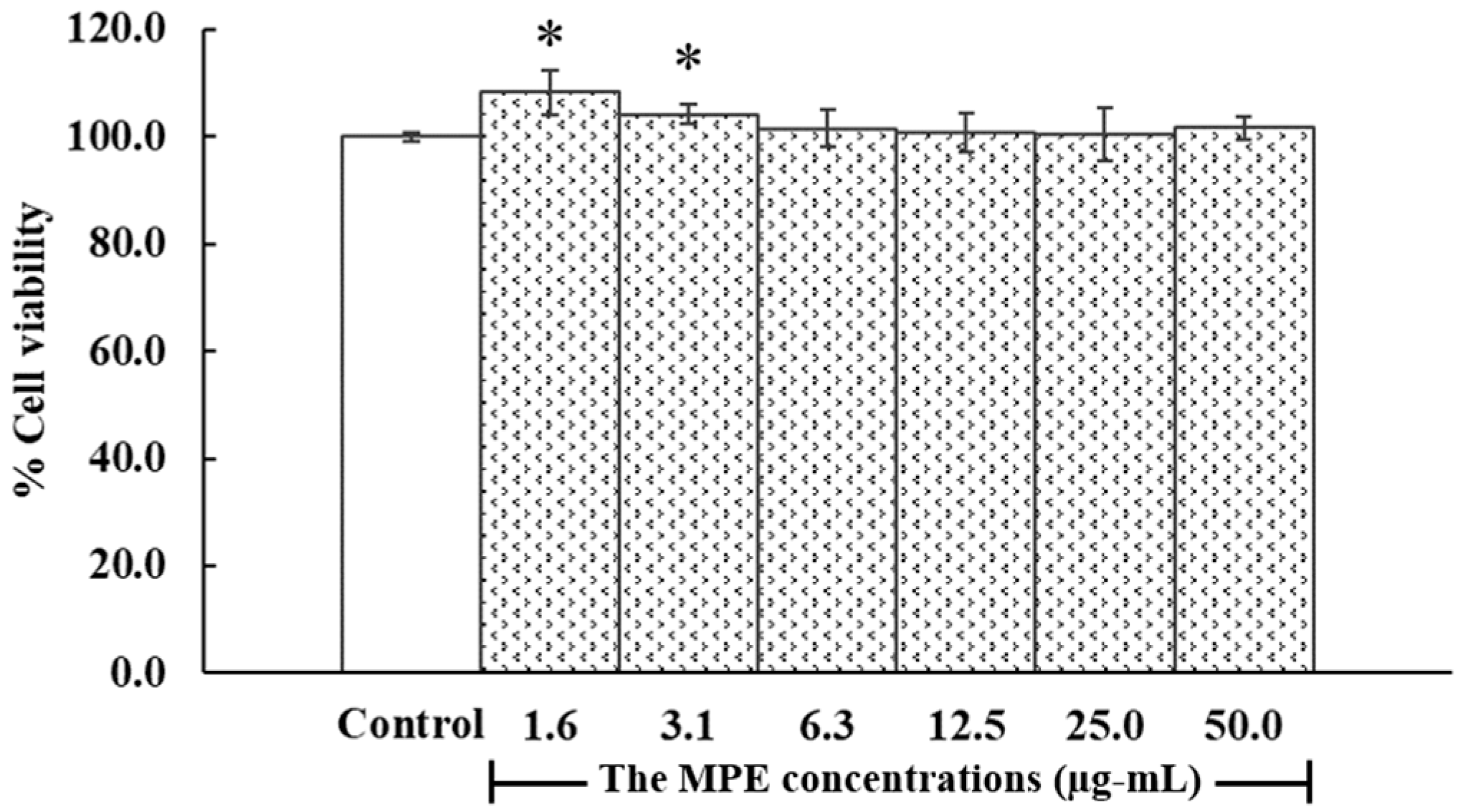
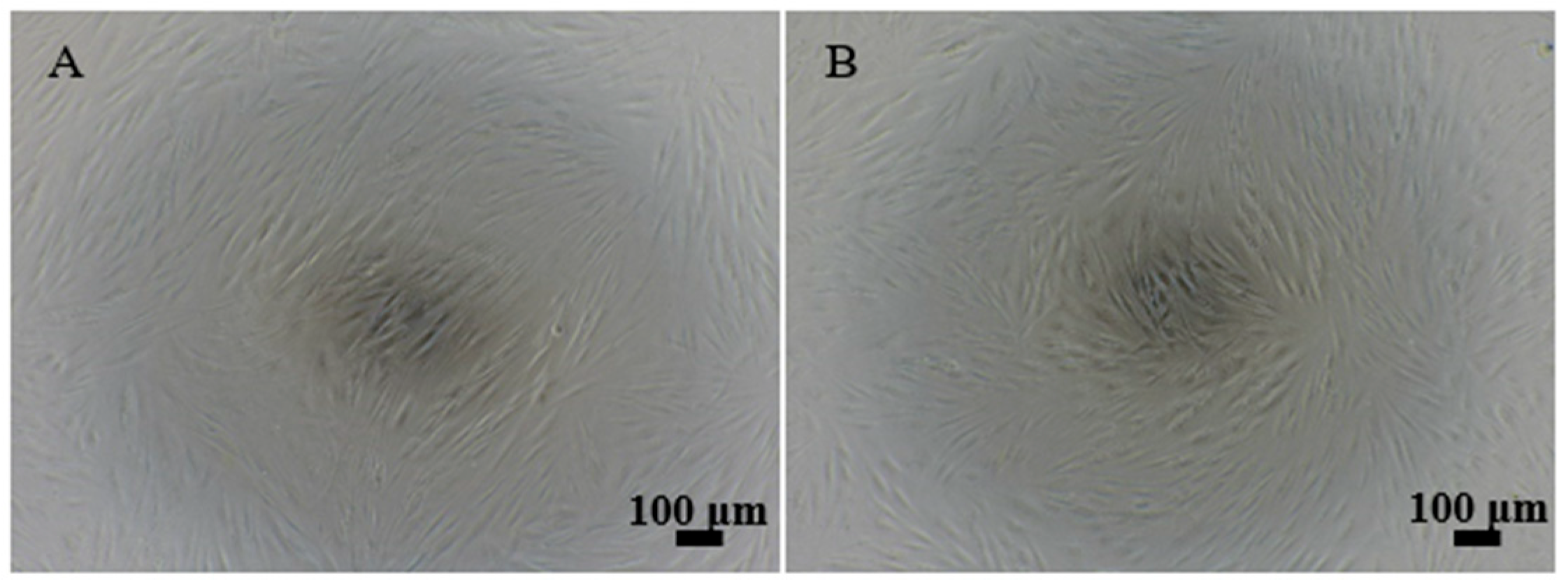

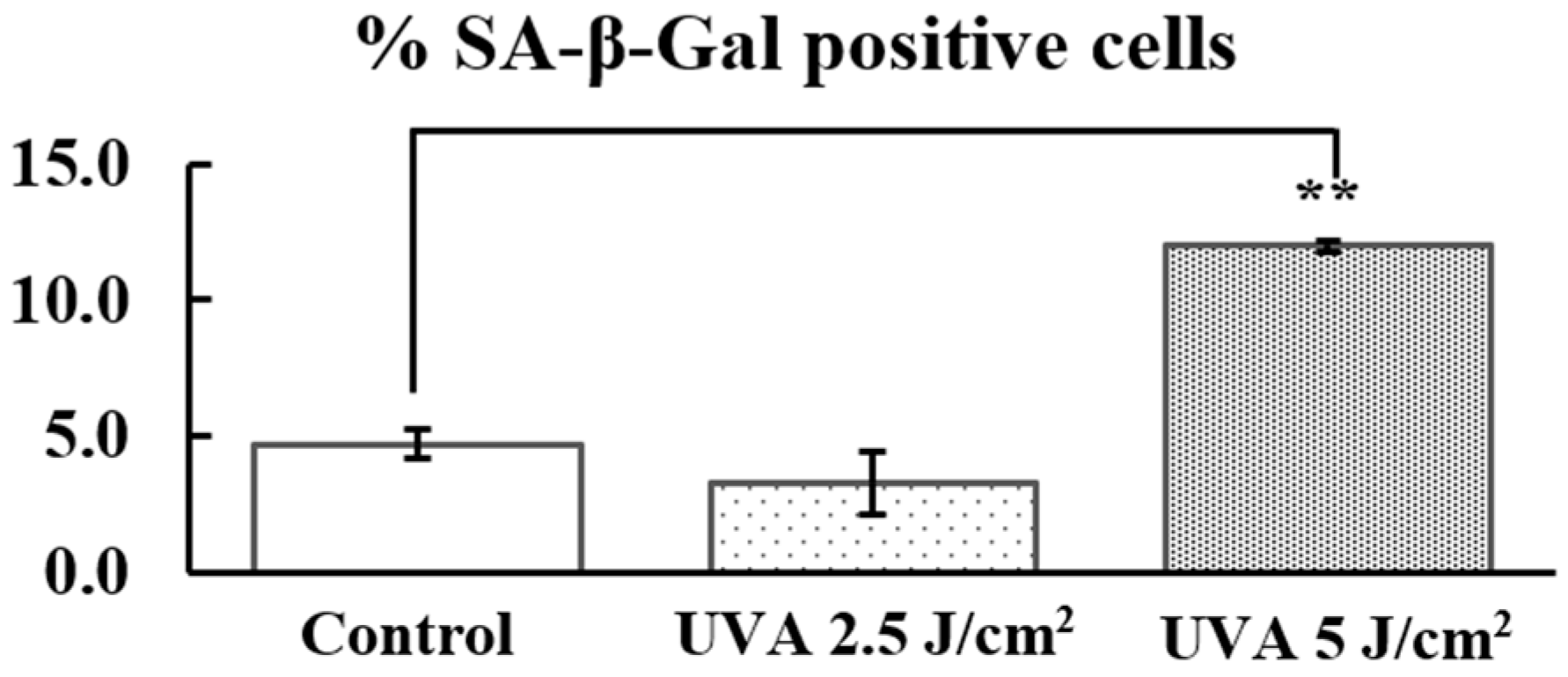


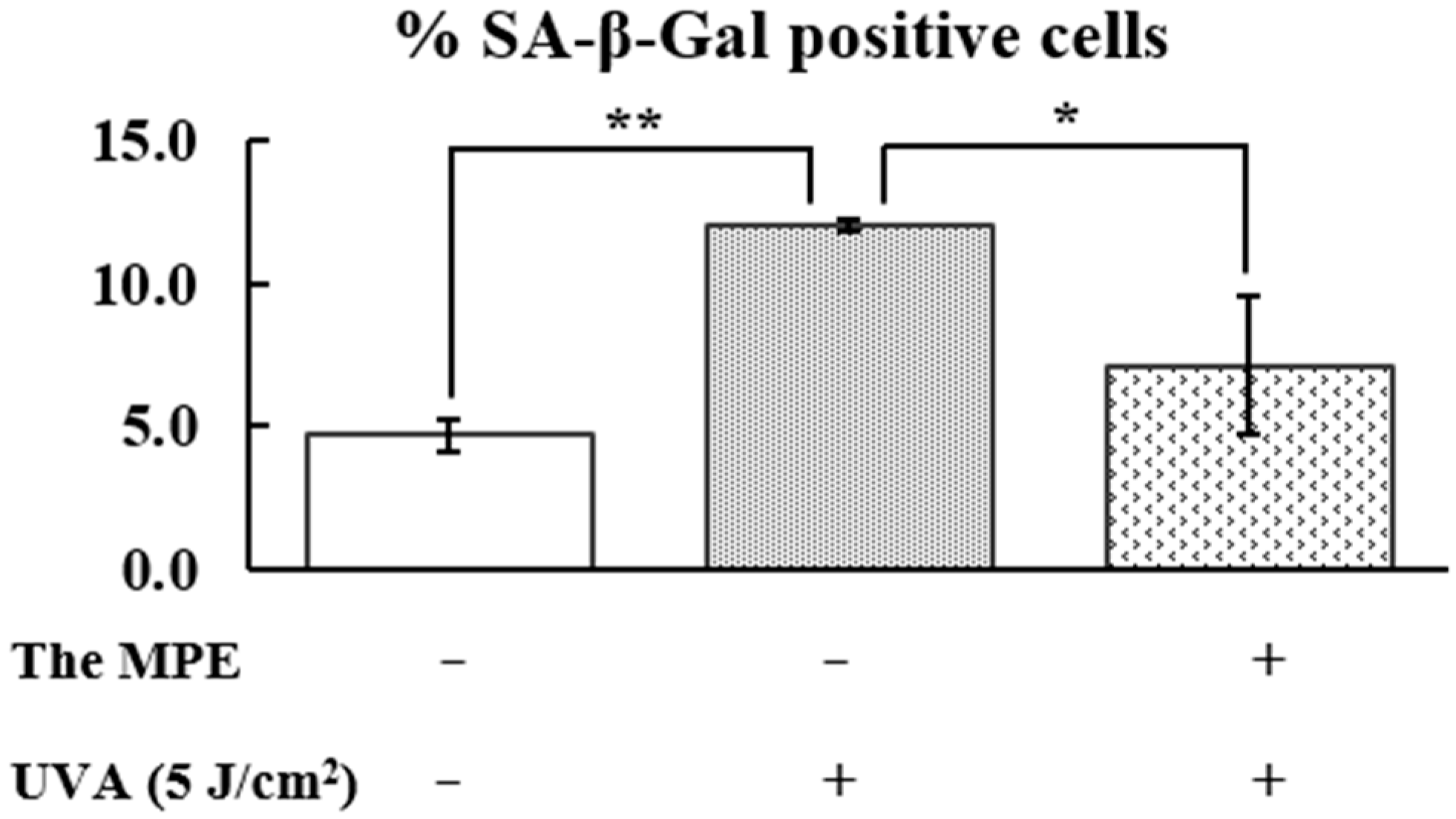
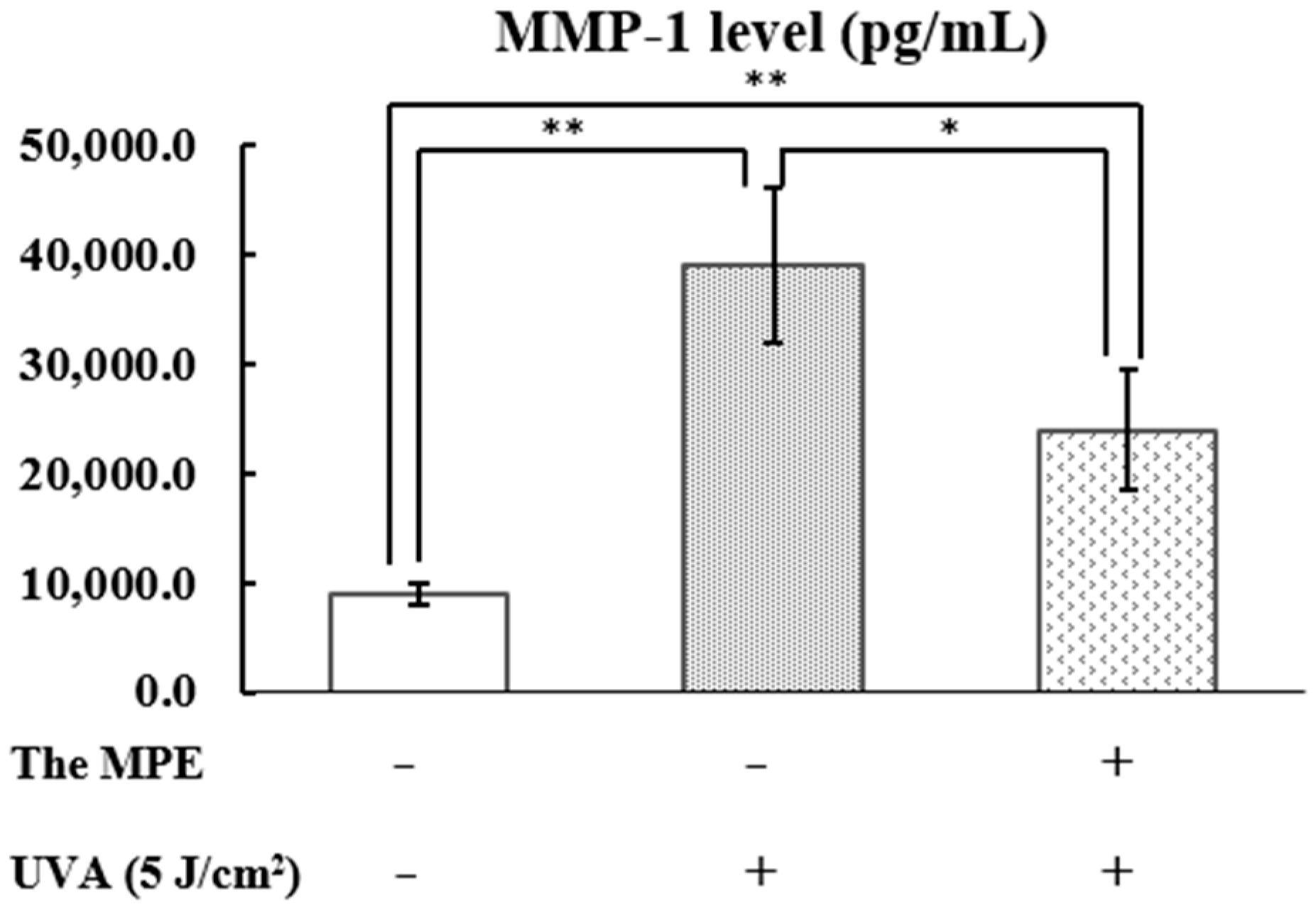
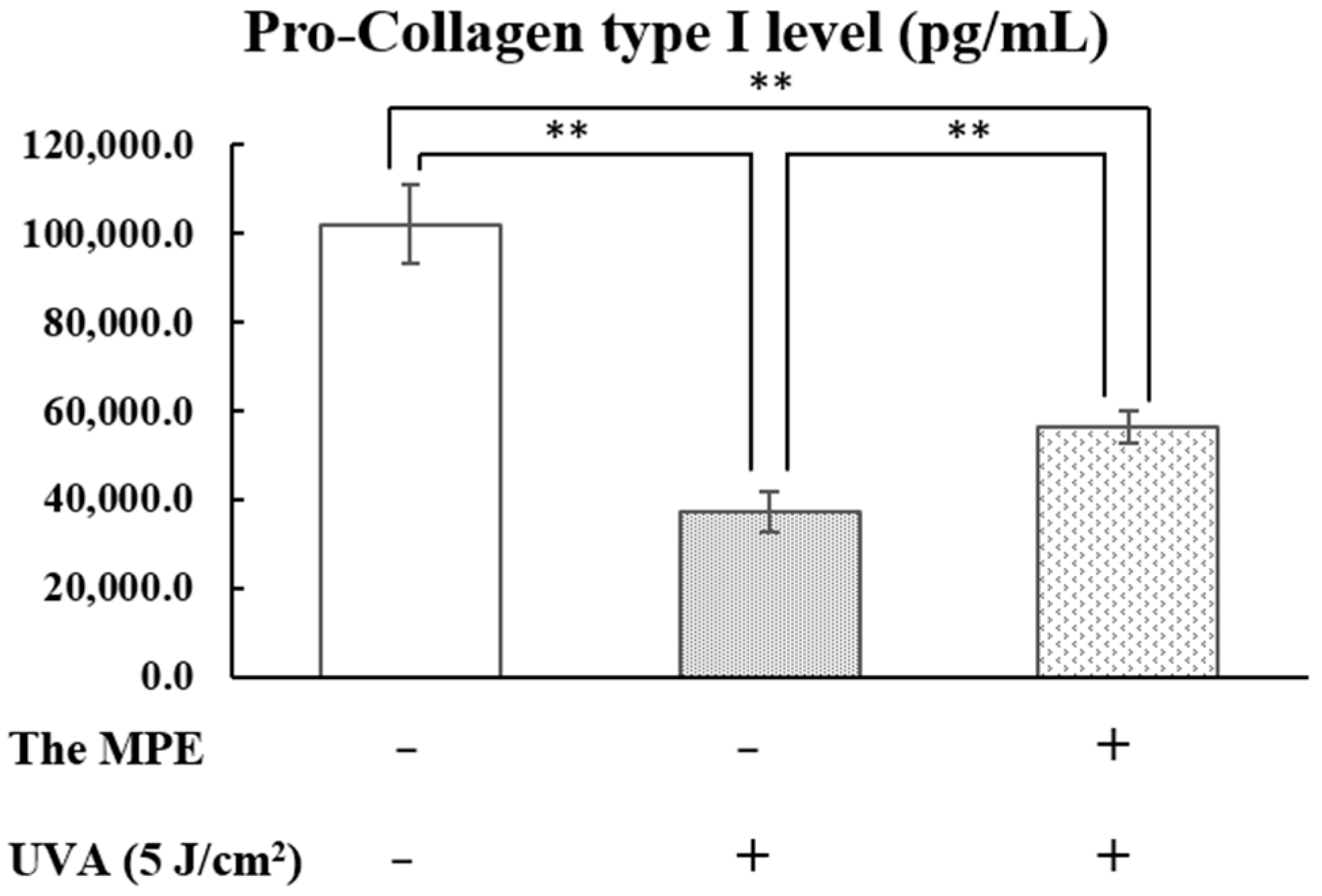
Disclaimer/Publisher’s Note: The statements, opinions and data contained in all publications are solely those of the individual author(s) and contributor(s) and not of MDPI and/or the editor(s). MDPI and/or the editor(s) disclaim responsibility for any injury to people or property resulting from any ideas, methods, instructions or products referred to in the content. |
© 2025 by the authors. Licensee MDPI, Basel, Switzerland. This article is an open access article distributed under the terms and conditions of the Creative Commons Attribution (CC BY) license (https://creativecommons.org/licenses/by/4.0/).
Share and Cite
Luangpraditkun, K.; Kasemkiatsakul, P.; Sangnim, T.; Yammen, S.; Pajoubpong, J.; Vongsak, B. Anti-Senescence and Anti-Photoaging Activities of Mangosteen Pericarp Extract on UVA-Induced Fibroblasts. Cosmetics 2025, 12, 108. https://doi.org/10.3390/cosmetics12030108
Luangpraditkun K, Kasemkiatsakul P, Sangnim T, Yammen S, Pajoubpong J, Vongsak B. Anti-Senescence and Anti-Photoaging Activities of Mangosteen Pericarp Extract on UVA-Induced Fibroblasts. Cosmetics. 2025; 12(3):108. https://doi.org/10.3390/cosmetics12030108
Chicago/Turabian StyleLuangpraditkun, Kunlathida, Piyachat Kasemkiatsakul, Tanikan Sangnim, Somnathtai Yammen, Jinnipha Pajoubpong, and Boonyadist Vongsak. 2025. "Anti-Senescence and Anti-Photoaging Activities of Mangosteen Pericarp Extract on UVA-Induced Fibroblasts" Cosmetics 12, no. 3: 108. https://doi.org/10.3390/cosmetics12030108
APA StyleLuangpraditkun, K., Kasemkiatsakul, P., Sangnim, T., Yammen, S., Pajoubpong, J., & Vongsak, B. (2025). Anti-Senescence and Anti-Photoaging Activities of Mangosteen Pericarp Extract on UVA-Induced Fibroblasts. Cosmetics, 12(3), 108. https://doi.org/10.3390/cosmetics12030108








